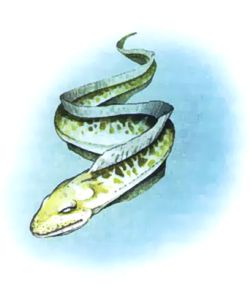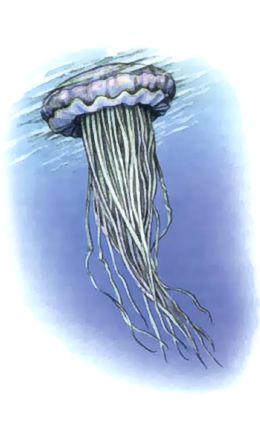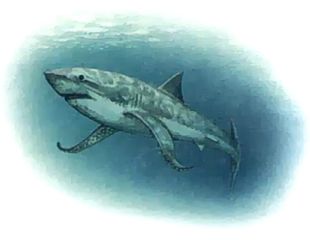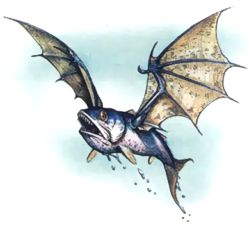Kreel
Kreel are large domesticated eels that lizard men use both as a source of food and as beasts of burden. When mature, they range from four to six feet long, and can be up to one foot in diameter.
Their coloration changes in a chameleonlike way to help camouflage them against their background. When near the surface of the sea, their backs turn blue-green and their bellies white. This helps to protect them from predators both above and below. When nearer the bottom of the sea, they become entirely dark.
Combat: Kreel are peaceful creatures, and they will only fight to defend themselves. They are incapable of using group tactics to fend off predators, tending to rely upon their camouflaging abilities to hide from such creatures.
When cornered, kreel will retaliate, but even then they will flee at the first opportunity. They often use their relative slimness to slip into places in the sea floor where predators cannot fit. A kreel caught by a shark in open waters, however, is an easy meal.
Habitat/Society: While a few kreel can be found swimming wild in Marnita, most belong to flocks tended by pairs of lizard men kreelherders. These lizard men ensure that the flock is well fed on the kelp growing wild throughout the sea and that it is safe from any wandering predators. Long-time kreelherders carry the scars of many battles with sharks, and some even tell of seeing the legendary squark.
Ecology: Down through the centuries, even rudimentary cunning has been bred out of the kreel. After all, sneaky creatures are difficult to care for. There is little doubt that, were the lizard men to abandon them, the kreel would be hunted to extinction by their natural enemies within a very short period of time.
Kreel graze on wild kelp, easily available just about anywhere in Marnita. Their meat is tasty (at least to lizard men), and their hides are extremely useful in all sorts of ways. They are the basis of the lizard man culture in the Last Sea, for without them the reptilian humanoids would be forced to look elsewhere for a large portion of their meals.
Puddingfish
The puddingfish is a gigantic sort of jellyfish found only in Athas’s Last Sea. It looks similar to a traditional jellyfish, only larger and slightly more substantial. Its dome is nearly eight feet across, and its tendrils drag down over 20 feet below it.
The creature is composed of a blue-green substance somewhat similar to that of a gelatinous cube. Due to its coloring, the puddingfish can be difficult to spot floating along in the water, and more than one fishing boat has run aground on a puddingfish’s back. This is usually little more than an annoyance, however, as the creature is unable to lift its tendrils upward at all. As long as no one falls into the water, the occupants of the boat will be fine.
Combat: When a small boat or raft runs into a puddingfish, each passenger near an edge should roll against his Dexterity to avoid falling into the sea. Those people unfortunate enough to end up in the drink next to a puddingfish had better swim away as fast as they can. The puddingfish is deadly when in contact with a victim, but it is slow to move and can be outdistanced by a strong swimmer. Of course, there are very few such people on Athas outside of the valley of the Last Sea.
A character struck by a puddingfish’s stinging tendrils must save vs. paralyzation or be paralyzed (anesthetized) for 4-16 (4d4) rounds. In the water, this can easily prove fatal unless the victim is fortunate enough to have a friend brave enough to haul his poisoned body out of the water. Once a victim has perished, the puddingfish’s snakelike tendrils draw the corpse up into its dome where it is slowly digested over a period of 3-6 (1d4+2) days.
Habitat/Society: Puddingfish are solitary creatures. They are asexual and reproduce by dividing once they have reached a certain critical mass. They are hunted by the lizard men for their hides (which are not poisonous), out of which many useful things such as clothing and sails are made.
Ecology: The dome of a puddingfish is actually its stomach, a place filled with horribly corrosive acids. This material can actually be harvested by foolhardy adventurers willing to risk their lives to obtain such potentially useful materials.
Shark, Athasian
Athasian sharks are similar to sharks of other worlds in many ways. They are large, cartilaginous, seagoing invertebrates that are basically cold-hearted eating machines. They are long and gray, and their mouths are filled with row after row of sharp, vicious teeth. The skin of an Athasian shark is fairly tough, and it is from this material that most lizard man shields are made.
Combat: In a battle, sharks are deadly foes. They tend to hunt in packs, and a person floundering about in the water is usually easy prey. They are fast, striking like lightning, often hitting and darting away before the victim is even aware of what has happened. Because of this, up to 10 sharks can attack a man-sized opponent in a single round.
Habitat/Society: Sharks tend to travel in packs for purposes of both hunting and safety. There is very little that can stand up to a school of hungry sharks in their element. The one thing that poises a certain danger for them, though, is a dolphin. Make a morale check each time a group of sharks is outnumbered by dolphins. If the sharks fail, they immediately scatter and flee, leaving their wounded behind in their single-minded desire to escape the dolphins’ wrath.
Athasian sharks (of which only a single species remains) are brighter than other sharks, but this translates more into animal cunning than any raw intelligence. They have been in constant conflict with the Last Sea’s dolphin population since the valley’s isolation nine millennia ago. Although they are bigger and stronger than their mammalian foes, they have no psionic abilities. Due mostly to this fact and their inability to formulate and stick to a decent battle plan, they have remained on the losing side of the majority of their battles with the dolphins. Occasionally they manage to victimize a lone dolphin, but rarely if ever are they able to sustain a serious attack against an entire pod.
Ecology: Little matters to sharks except where their next meal is coming from. While their favorite meal is undoubtedly dolphin, they are the ultimate omnivores, willing to eat pretty much anything. They can smell blood in the sea from up to a mile away, and once they get its scent, they will pursue it until either they find the source or discover that it has somehow gotten away.
Skyfish
A skyfish is a special kind of amphibious creature that has the ability to survive both far below and high above the waves of Marnita. These creatures look like silvery sea bass with large batlike wings covered with scales instead of feathers. Their mouths end not in a beak but a ferocious set of teeth suitable for picking up and rending the smaller fish off of which they typically live.
The arches of the wings of a skyfish end in tiny claws which the animal can use to grip things while not using its wings for flying. When in the water, it folds these wings in close to itself so that it can swim with little resistance. To fly, a skyfish simply leaps out of the water and into the air and spreads its wings wide.
Combat: Skyfish rarely hunt in packs, preferring to take after their prey on their own. They like to circle high above the waves until they spot a smaller fish swimming near the surface. Then they dart in and carry the creature into the air, holding it in their mouth until it dies in the open air. Then they take the creature back into the water where they can finish their meal.
Skyfish will only bother people if the people are already bothering them. This happens occasionally when a fisher manages to catch one of these creatures on a line baited for other game. If the fisher can manage to reel the skyfish in, he is in for a tasty treat. Skyfish are considered to be one of the finest delicacies in Saragar. But to land his catch, the fisher is in for something of a battle.
Habitat/Society: Skyfish mate for life. They lay large, birdlike eggs, which they keep protected in underwater nests until hatched. While there are eggs or young to be protected, one of the parents stays with the precious things while the other hunts for food for the family. Skyfish usually hunt alone, but they have been known to band into flocks to take down large prey.
Ecology: The skyfish seems to have the best of both worlds. Since the creatures can breathe both air and water equally well, they can escape predators that are based solely in either element. For this reason, the skyfish population is always high. Were it not for the fact that the people of the Last Sea hunt these creatures for their tasty flesh, they might have literally overrun the entire valley. As it is, a canny fisher rarely has to wait long to find a skyfish in one of his nets.

